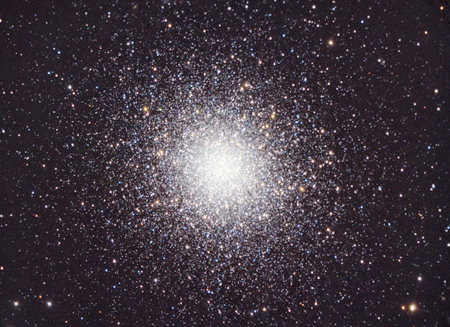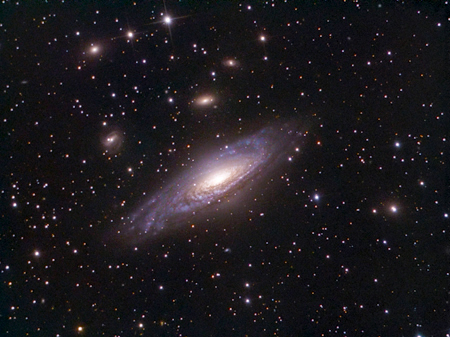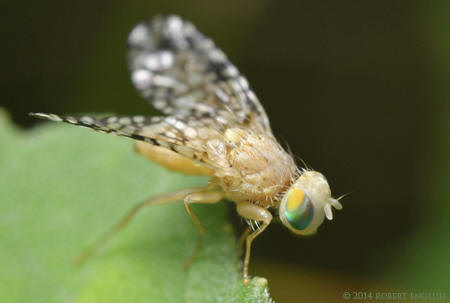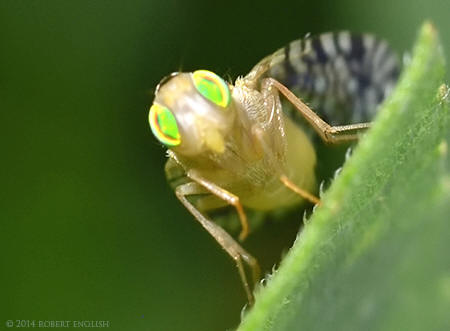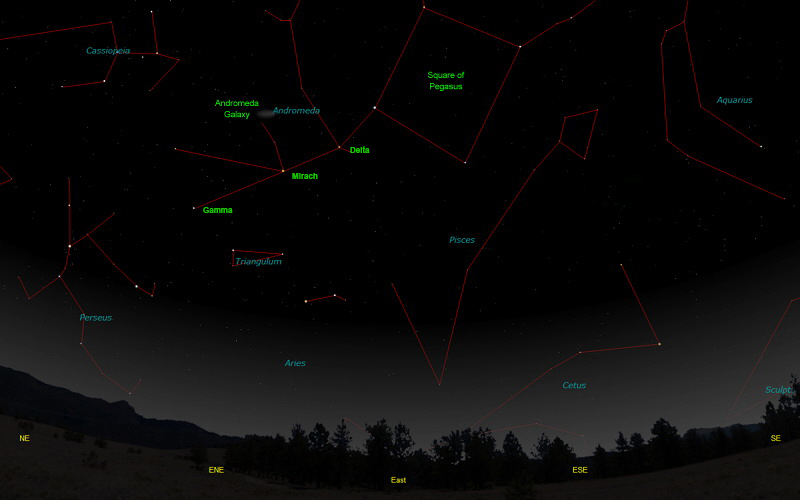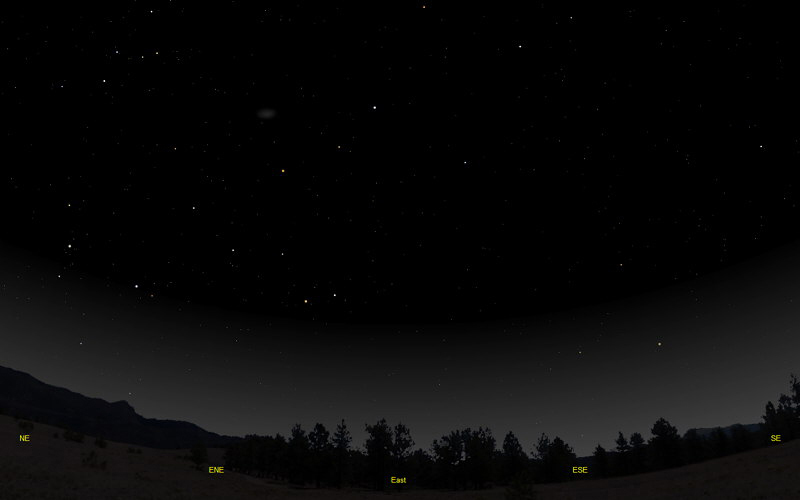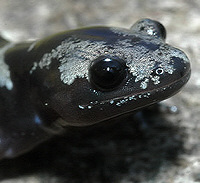The purpose of this feature is to give scout leaders, educators and naturalists an idea of some of the natural events coming up each month. We will try to cover a variety of natural events ranging from sky events to calling periods of amphibians, bird and mammal watching tips, prominent wildflowers and anything else that comes to mind. We will also note prominent constellations appearing over the eastern horizon at mid-evening each month for our area for those who would like to learn the constellations. If you have suggestions for other types of natural information you would like to see added to this calendar, let us know! Note: You can click on the hyperlinks to learn more about some of the featured items. To return to the Calendar, hit the "back" button on your browser, NOT the "back" button on the web page. All charts are available in a "printer friendly" mode, with black stars on a white background. Left clicking on each chart will take you to a printable black and white image. Please note that images on these pages are meant to be displayed at 100%. If your browser zooms into a higher magnification than that, the images may lose quality. Though we link book references to nationwide sources, we encourage you to support your local book store whenever possible. Notes and Images From August 2014
In August we continued to test the various systems of the new telescope, and occasionally had a chance to do a little imaging. On the 14th we had a brief break in our typical murky summer skies and we made an 80-minute exposure of Messier 13. This globular cluster is around 22,000 light-years away in the constellation of Hercules. M-13 is like an old friend to me. It was one of the first "deep sky" objects that I looked at with the 6 inch reflecting telescope I built in high school. But this image revealed a new wrinkle to me. I had never really noticed the contrast between the old red cluster stars and the blue stars that are sprinkled throughout the cluster. These blue stars are called "blue stragglers" and are thought to be formed by the interaction of stars within the cluster. Also seen in the image above are three intersecting dark lanes that are located off the center of the cluster at about the 4 o'clock position. This feature can be seen in larger scopes and has been nicknamed "the propeller".
Our target on August 22nd was much farther away. Then evening wasn't quite as clear as the 14th, with a few passing high clouds. The exposure at left is a four hour exposure of the galaxy NGC 7331 in Pegasus. This galaxy is about 59 million light-years away, and the brighter background galaxies are several hundred million light-years distant. The faintest galaxies visible are much farther away than that. The center of the galaxy appears to be warped relative to the outer spiral arms, and there is a faint ellipsoidal glow that extends from the nucleus of the galaxy along its polar axis. NGC 7331 was discovered by William Herschel in 1784, three years after he discovered the planet Uranus.
One of the nice things about having good habitat is that you can take a great field trip in your own yard. We spent some time around the border of our pond this month and found several interesting species. The fruit fly at right is one of them. I spotted it on a cocklebur leaf and was amazed at the changing colors of its eyes as light hit them from different angles. I've never seen so much color in the eyes of an insect. The colors probably stem from various refractions and reflections in the compound eyes. The wings are also interesting, with a see-through polka dot pattern throughout.
Some species of fruit flies can be agricultural pests, but this species is actually quite beneficial. Its host is cocklebur, so it tends to act as a natural control of the plant. It is native to our area and is endemic to the Americas. It has been introduced to Fiji and Australia to act as a biological control agent to the cocklebur. Cocklebur tends to get a little out of control at the margins of our pond during the dryer parts of the summer, so we're glad to have this particular species around.
We've recently been spending a little time trying to increase our knowledge of spiders. Most of our reference books were not very good, so we were glad to get a recommendation for the book, Common Spiders of North America, by Richard Bradley. I was aware of Wolf Spiders, for instance, but in the Bradley book there are eight plates of different species of Wolf Spiders. Of course, there are those who think one page is probably enough. But most spiders are not harmful to humans, and some, like the jumping spider at right, are quite beautiful, at least in a spider kind of way.
There is probably a little bit of Ron Weasley in all of us, but we've enjoyed learning about the spider species we have around us. Though beauty is in the eye of the beholder, and I have to say some species still give me a little jolt when I see them up close. One species that I would not call handsome (link not recommended for arachnophobes) is here. Sometimes I'm very glad that we're big and they're small. But most spiders are beneficial to us and are important in controlling harmful insect species. Both of the species shown here were on the cocklebur at the water's edge.
Sky Events for September 2014: The Autumnal Equinox, marking the beginning of fall in the Northern Hemisphere, occurs at 9:29 pm CDT on September 22nd. Evening Sky: Mars keeps getting fainter and smaller in the eyepiece as the distance between Earth and Mars increases. It is now only about 7 seconds of an arc in apparent diameter. At the beginning of the month, look for it in Libra about 22 degrees above the southwest horizon at dusk, about 5 degrees to the left of Saturn, and a little lower. On September 27th and 28th, watch Mars pass 3 degrees above Antares, the brightest star in Scorpius. Antares means "rival of Mars" and this will be a good chance to compare the brightness and color of the star and the planet. Saturn remains in Libra. Look for it low in the southwestern sky at dusk, about 24 degrees above the horizon, at the beginning of the month. The rings are now tilted to around 23 degrees from edge-on, giving a wonderful view of the ring system in any size telescope, though atmospheric turbulence will blur the view somewhat when it is this close to the horizon. Morning Sky: Jupiter is above brighter Venus in the brightening sky before sunrise. Look for it due east about 25 degrees above the horizon an hour before sunrise on September 1st. Venus continues to shine in the dawn sky during September. Look for it below Jupiter in the dawn sky. It will be much brighter than Jupiter. All times noted in the Sky Events are for Franklin, Tennessee and are Central Daylight Time. These times should be pretty close anywhere in the mid-state area. Constellations: The views below show the sky looking east at 10:00pm CDT on September 15th. The first view shows the sky with the constellations outlined and names depicted. Star and planet names are in green. Constellation names are in blue. The second view shows the same scene without labels. Pegasus appears higher above the eastern horizon, as does Andromeda. Perseus is above the horizon now, and Cetus is also beginning to appear. The faint stars of Pisces should be easier to pick out this month.
Find the "Square of Pegasus" and work your way outward from it to the constellations around it. See if you can pick out the faint glow of the Andromeda Galaxy, over 2 million light years away! When you look at this galaxy you're seeing light that began its journey to us in the Pleistocene epoch. To get the best view, wait until the galaxy climbs high in the sky. The Andromeda Galaxy was first shown on star charts prepared in 905AD by the Persian astronomer, Al Sufi, and was referred to as the "Little Cloud." That describes well its appearance to the naked eye. Binoculars will greatly improve your view, as will driving out of the city and finding darker skies. Simon Marius, in 1610, was among the first to observe the Andromeda Galaxy through a small telescope. He compared its soft glow to "the light of a candle shining through horn." In dark skies, those using small telescopes may pick out the small satellite galaxies M32 (above and left of the nucleus of M31 in the above image) and NGC 205 (below). A faint tidal bridge connects NGC 205 to Messier 31. Our Milky Way Galaxy and the Andromeda Galaxy are approaching each other and are expected to collide in approximately 4.5 billion years. The two galaxies may merge into a single giant elliptical galaxy at that time.
On Learning the Constellations: We advise learning a few constellations each month, and then following them through the seasons. Once you associate a particular constellation coming over the eastern horizon at a certain time of year, you may start thinking about it like an old friend, looking forward to its arrival each season. The stars in the evening scene above, for instance, will always be in the same place relative to the horizon at the same time and date each September. Of course, the planets do move slowly through the constellations, but with practice you will learn to identify them from their appearance. In particular, learn the brightest stars for they will guide you to the fainter stars. Once you can locate the more prominent constellations, you can "branch out" to other constellations around them. It may take you a little while to get a sense of scale, to translate what you see on the computer screen or what you see on the page of a book to what you see in the sky. Look for patterns, like the stars that make up the "Square of Pegasus." The earth's rotation causes the constellations to appear to
move across the sky just as the sun and the moon appear to do. If you go
outside earlier than the time shown on the charts, the constellations will be
lower to the eastern horizon. If you observe later, they will have climbed
higher. As each season progresses, the earth's motion around the sun causes the constellations to appear a little farther towards the west each night for any given time of night. If you want to see where the constellations in the above figures will be on October 15th at 10:00pm CDT, you can stay up till midnight CDT on September 15th and get a preview. The westward motion of the constellations is equivalent to two hours per month. Recommended: Sky & Telescope's Pocket Star Atlas is beautiful, compact star atlas. A good book to learn the constellations is Patterns in the Sky, by Hewitt-White. You may also want to check out at H. A. Rey's classic, The Stars, A New Way to See Them. For skywatching tips, an inexpensive good guide is Secrets of Stargazing, by Becky Ramotowski. A good general reference book on astronomy is the Peterson
Field Guide,
A Field Guide to the Stars and Planets, by Pasachoff. The book retails for around $14.00. Starry Night has several software programs for learning the night sky. Visit the Starry Night web site at www.starrynight.com for details. The Virtual Moon Atlas is a terrific way to learn the surface features of the Moon. And it's free software. You can download the Virtual Moon Atlas here. Cartes du Ciel (described in the monthly notes above) is a great program for finding your way around the sky. It is also free, and can be downloaded here. Apps: We really love the Sky Safari Pro application described here. For upcoming events, the Sky Week application is quite nice. Both apps are available for both I-phone and Android operating systems. The newest version, Sky Safari 4, is available here.
Amphibians:
The frog and toad choruses start waning in September but some frogs and toads are still calling. Another name for the Spring Peeper is the "Autumn Piper", and these small frogs can be heard calling from patches of woods in the fall. Listen also for a very dry, scratchy version of the Upland Chorus Frog's song on rainy days and nights in September. We've been hearing Southern Leopard Frogs quite a bit this August, and they should really pick up in September as the cooler temperatures mirror their early spring breeding period. You can locate many of the frogs and toads that have been calling more frequently earlier in the year by driving the back roads slowly on rainy nights.
This is a two person job. One person watches the road for amphibians and one person looks out for other vehicles. Anything over about 15mph is "speeding." On wet nights in September, look for breeding Marbled Salamanders in flooded woodland areas. We found one such area where we had previously heard a breeding chorus of Upland Chorus Frogs. Recommended: The Frogs and Toads of North America, Lang Elliott, Houghton Mifflin Co. Archives (Remember to use the back button on your browser, NOT the back button on the web page!) Natural Calendar February 2014 Natural Calendar December 2013 Natural Calendar November 2013 Natural Calendar September 2013 Natural Calendar December 2012 Natural Calendar November 2012 Natural Calendar September 2012 Natural Calendar February 2012 Natural Calendar December 2011 Natural Calendar November 2011 Natural Calendar September 2011 Natural Calendar February 2011 Natural Calendar December 2010 Natural Calendar November 2010 Natural Calendar September 2010 Natural Calendar February 2010 Natural Calendar December 2009 Natural Calendar November 2009 Natural Calendar September 2009 Natural Calendar February 2009 Natural Calendar December 2008 Natural Calendar November 2008 Natural Calendar September 2008 Natural Calendar February 2008 Natural Calendar December 2007 Natural Calendar November 2007 Natural Calendar September 2007 Natural Calendar February 2007 Natural Calendar December 2006 Natural Calendar November 2006 Natural Calendar September 2006 Natural Calendar February 2006
Natural Calendar December 2005
Natural Calendar November 2005
Natural Calendar September 2005
Natural Calendar February 2005
Natural Calendar December 2004
Natural Calendar November 2004
Natural Calendar September 2004
Natural Calendar February 2004
Natural Calendar December 2003
Natural Calendar November 2003
Natural Calendar September 2003 Natural Calendar February 2003 Natural Calendar December 2002 Natural Calendar November 2002 Nature Notes Archives: Nature Notes was a page we published in 2001 and 2002 containing our observations about everything from the northern lights display of November 2001 to frog and salamander egg masses. Night scenes prepared with The Sky Professional from Software Bisque All images and recordings © 2014 Leaps |
|||||||||||||||||||
